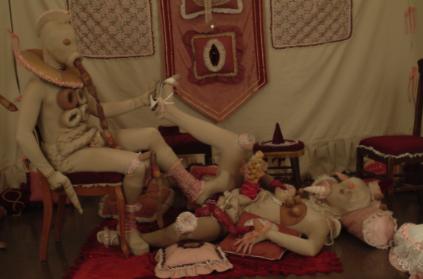
Pavilion of Virginia Puff-Paint, 2004 (Will Munro + Jeremy Laing). Credit: Courtesy of Art Gallery of York University, Toronto.
For a sector of the Toronto queer community, Will Munro’s death was a bit like Sept 11 and the 2003 blackout combined. The queer club promoter, activist and visual artist’s passing was met with profound shock and sadness, but was mixed with a surprising and unexpected joy at the recognition of the community he helped build.
Along with the values of solidarity, activism and the right to define one’s own queer identity I took from his life, I learned something unexpected from his death. I received the news that his two-year battle with brain cancer had ended while I was at a film screening. Shocked, I turned to the 22-year-old friend I was with, unsure of what to say. He promptly asked “Who’s Will Munro?”
The sad fact I learned in that moment is that queer history is often forgotten as quickly as it’s written. A new generation could party at west end queer spaces, spurred by the launch of The Beaver Café (which Munro bought with Lynn McNeill in 2006). But how this movement was forged, and the name of its de facto leader, was lost to them.
Whether Will Munro was an unknown commodity or a personal friend, the Art Gallery of York University’s expansive retrospective, fittingly titled History, Glamour, Magic, will prove an enlightening look at the contemporary queer icon. Curated by Philip Monk and Emelie Chhangur, it spans Munro’s creative output from his time at OCAD until his death. Incorporating drawings, posters, films, photographs, installations and, of course, his infamous salvaged underwear textile assemblages, the exhibition captures Munro’s essence, drawing little distinction between art, life and activism.
Monk and Chhangur were long-time friends and collaborators of Munro’s. (The AGYU presented his work several times, and opening-night parties were held at The Beaver.) Their decision to mount the exhibition was made the day after he died.
“There wasn’t really a conversation about whether or not we should do a show,” says Chhangur. “It was something we immediately knew we had to do.”
“We reacted emotionally with our desire to present his work, but there was also an intellectual reason,” Monk adds. “We felt we would be the only gallery that could do a proper, comprehensive exhibition that would give Will his full credit.”
True to Munro’s spirit, the show was conceived in a participatory manner, bringing many of his long-time friends and collaborators into the process, including Luis Jacob, Lex Vaughn, John Caffery, Jeremy Laing and Allyson Mitchell. Rather than create a static, monolithic view of the artist, the curators have articulated his legacy through a series of participatory programs throughout the exhibition, including events with the Feminist Art Gallery, the Gladstone Hotel and the West Side Stitches Couture Club.
Munro’s overarching commitment to the queer community and its history is ever present in the show. His homages to Leigh Bowery, Klaus Nomi and 1970s leather culture speak not just to a fascination with the past, but a genuine admiration for the gay struggles that came before. The Lezbro Room, a chill-out space at the end of the exhibition, commemorates his commitment to queer women and their role in his life, particularly in caring for him in his final days.
“A lot of his work was made in a commemorative fashion for these iconic queer heroes,” Monk says. “He was able to marry his DIY punk aesthetic with a desire to preserve these people who may otherwise be forgotten or unknown. If people ask who Will Munro is, you might say he’s someone who helped us preserve queer history.”
The Deets:
Will Munro:
History, Glamour, Magic
Wed, Jan 11-Sun, March 11
Opening reception: Wed, Jan 11, 6-9pm
Art Gallery of York University
Accolade East Building, York University
4700 Keele St, Toronto


 Why you can trust Xtra
Why you can trust Xtra


